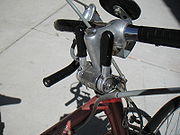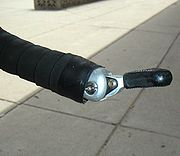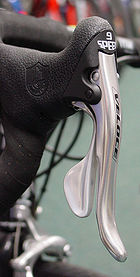.gif)
Shifter (bicycle part)
Encyclopedia







Bicycle
A bicycle, also known as a bike, pushbike or cycle, is a human-powered, pedal-driven, single-track vehicle, having two wheels attached to a frame, one behind the other. A person who rides a bicycle is called a cyclist, or bicyclist....
shifter or gear control or gear levers is a component used to control the gearing mechanisms and select the desired gear ratio. Typically, they operate either a derailleur
Derailleur gears
Derailleur gears are a variable-ratio transmission system commonly used on bicycles, consisting of a chain, multiple sprockets of different sizes, and a mechanism to move the chain from one sprocket to another...
mechanism or an internal hub gear
Hub gear
A hub gear, internal-gear hub, or just gear hub is a gear ratio changing system commonly used on bicycles that is implemented with planetary or epicyclic gears. The gears and lubricants are sealed within the hub-shell of the bicycle's rear wheel, as opposed to derailleur gears, where the gears and...
mechanism. In either case, the control is operated by moving a cable
Bowden cable
A Bowden cable is a type of flexible cable used to transmit mechanical force or energy by the movement of an inner cable relative to a hollow outer cable housing...
that connects the shifter to the gear mechanism. Shifters are mounted on the down tube of the frame, on the handlebars
Bicycle handlebar
Bicycle handlebar or often bicycle handlebars refers to the steering mechanism for bicycles; the equivalent of a steering wheel. Besides steering, handlebars also often support a portion of the rider's weight, depending on their riding position, and provide a convenient mounting place for brake...
, or at the ends of triathlon bars. Major manufacturers of shifters include Shimano
Shimano
Shimano, Inc. is a Japanese multinational manufacturer of cycling components, fishing tackle, and rowing equipment.In 2005, the company had net sales of US $1.4 billion. Bicycle components provided 75% of its sales income...
, Campagnolo
Campagnolo
Campagnolo is an Italian manufacturer of high-end bicycle components with headquarters in Vicenza, Italy. The components are organised as groupsets and are a near-complete collection of a bicycle's mechanical parts. Campagnolo's flagship components are the Super Record, Record, and Chorus...
, and SRAM
SRAM (bicycles)
SRAM Corporation is a privately held bicycle component manufacturer based in Chicago, Illinois, founded in 1987. SRAM is an acronym comprising the names of its founders, Scott, Ray, and Sam, .In 2008, the company received a strategic investment from Trilantic Capital Partners, formerly known as...
.
The controls are mounted so that the right shifter controls the rear derailleur and the left shifter controls the front derailleur. For hub gears, the control is also mounted on the right.
Over the years, many different kinds of shifters have been used. The trend in development has been to reduce the need for the rider to direct attention away from riding. Friction shifters gave way to index shifters, which do not require fine-tuning during a gear change. In the 1990s, shifters were placed closer to the hand positions on the handlebars, up to the point of being integrated with the brake lever control.
Friction shifting
Originally, gear control levers consisted of a simple lever. Changing gears required pushing or pulling the lever so that the derailleur would move the chainBicycle chain
A bicycle chain is a roller chain that transfers power from the pedals to the drive-wheel of a bicycle, thus propelling it. Most bicycle chains are made from plain carbon or alloy steel, but some are nickel-plated to prevent rust, or simply for aesthetics. Nickel also confers a measure of...
to a different sprocket
Sprocket
A sprocket or sprocket-wheel is a profiled wheel with teeth, cogs, or even sprockets that mesh with a chain, track or other perforated or indented material. The name 'sprocket' applies generally to any wheel upon which are radial projections that engage a chain passing over it...
on the rear hub. The cyclist would need to adjust the lever to center the chain on the sprocket.
This system started out with 2 or 3 sprockets, and by the 1970s had developed to 5 and 6 sprockets. Many inexperienced cyclists, especially those who started in the US 1970s bike boom
Bike boom
Bike boom or bicycle craze refers to several different times when, for a period of a few years, many people in many parts of Europe and North America wanted to buy and ride a bicycle. In brief, they occurred in 1819, 1868, the decade of the 1890s, and the 1970s...
, found it difficult to change gear accurately. Typical difficulties included gear changes that left the chain in between two sprockets, which causes noisy rattles, or undesired and unexpected gear changes. However, many experienced cyclists still prefer friction gears for their simplicity and long-term reliability, as well as the ability to mix and match components from different manufacturers without the compatibility issues of indexing systems. Another benefit of friction shifting is the ability to shift from the lowest to highest gear in one simple motion. In addition, the introduction of ramped freewheel sprockets (such as Shimano's Hyperglide
Hyperglide
Hyperglide is the name given to the series of ramps in bicycle derailleur tooth cassette systems. It varies gear tooth profiles, and/or pins along the faces of freewheel or cassette sprockets, or between the chainrings in a crankset, to ease shifting between them.-Development:The design, developed...
system) and derailleurs with floating jockey wheels has made accurate gear changes much easier than previously. Friction or ratcheting shifters remain popular for front derailleurs, since only two or three chainrings are used, and allow trimming of the front derailleur.
Index shifting
Index shifting is a system where the control has discrete stops. Hub gears by design are indexed, but for derailleur systems, indexing was an innovation. Each stop corresponds to one position of the derailleur. This allows the cyclist to change gear without having to adjust each time, as in friction shifting.The first successful indexed shifting system was the Shimano Index Shifting or SIS, introduced in 1984 on the 6-speed Dura-Ace racing groupset. This made it near impossible to misshift, but at the expense of having more difficult initial adjustment. Most modern bikes made today are equipped with index shifting. Prior to this Shimano had sold a system called Positron in which the indexing mechanism was placed in the derailleur; however this system was only targeted at cheaper bicycles and gained a bad reputation. In all modern indexed shifting systems, the indexing mechanism is placed in the shifters.
Index shifter styles include twist shifters, trigger shifters (such as Shimano's Rapidfire design), shifters integrated with brake levers, levers mounted on the downtube, and bar-end controls. A twist shifter is mounted in line with the handlebar grips. Shifting is controlled by rotating the grip of the shifter. Trigger shifters have separate levers that change gears to the next gear up or down. Early indexed shifters could be used in friction mode for backwards compatibility, but this feature is no longer common.
New mountain bicycles use either twist shifters or trigger shifters. Older mountain bicycles may have thumb shifters, often indexed for the rear derailleur and friction for the front. Shimano's Deore, LX, XT, and XTR mountain groupsets include combined brake/shift controls, called Dual-control. Moving the brake lever perpendicular to the direction to control the brakes operates the shift mechanism.
Given that friction shifters were compatible with almost any derailleur, index shifting systems have been criticized for their non-interchangeability. For example, Shimano indexing components are often incompatible with SRAM or Campagnolo
Campagnolo
Campagnolo is an Italian manufacturer of high-end bicycle components with headquarters in Vicenza, Italy. The components are organised as groupsets and are a near-complete collection of a bicycle's mechanical parts. Campagnolo's flagship components are the Super Record, Record, and Chorus...
components, because the amount of cable pulled between each "click" is different in each system. For example, a typical Shimano (2:1), 7-speed shifter changes the cable length by 2.9mm between each gear, while a similar 7-speed SRAM (1:1) shifter changes the cable length by 4.5mm; some other SRAM units, (that differ only by an MRX designator), are compatible with Shimano units. In addition, newer components are often not backward compatible with older systems from the same manufacturer, so finding spares for older systems is often difficult, and stocking all of the possible combinations (shifters, derailleurs, chainrings
Crankset
The crankset or chainset , is the component of a bicycle drivetrain that converts the reciprocating motion of the rider's legs into rotational motion used to drive the chain, which in turn drives the rear wheel...
, freewheels, and cassettes
Cassette (bicycle part)
On a bicycle, the cogset or cluster is the set of multiple rear sprockets that attaches to the hub on the rear wheel. A cogset works with a rear derailleur as part of the drivetrain to provide multiple gear ratios to the rider. Cogsets come in two varieties, cassettes or freewheels, of which...
) is a challenge for the local bike shop. Some components can be mixed and matched between systems, but it can be a bit of a kludge
Kludge
A kludge is a workaround, a quick-and-dirty solution, a clumsy or inelegant, yet effective, solution to a problem, typically using parts that are cobbled together...
to do so. Component manufacturers have been accused of planned obsolescence
Planned obsolescence
Planned obsolescence or built-in obsolescence in industrial design is a policy of deliberately planning or designing a product with a limited useful life, so it will become obsolete or nonfunctional after a certain period of time...
for introducing more and more complicated shifting systems—and withdrawing support for older systems—to a riding public which generally doesn't need so many gears for basic transport, utility
Utility cycling
Utility cycling encompasses any cycling not done primarily for fitness, recreation such as cycle touring, or sport such as cycle racing, but simply as a means of transport...
, or recreational cycling.
One notable exception to the lack of compatibility in modern shifters is the fact that none of Campagnolo's front shifters are indexed, so they are compatible with all double or triple cranksets, even those of different manufacturers. Campagnolo rear shifters are also partially backwards compatible because a mechanic can upgrade them for use with a different number of rear sprockets by replacing a small part, the shift disc.
Shifter Designs
Older road bike shifters may be down tube gear levers, mounted on the down tube of the frame. These have been available both non-indexed (friction) and indexed. If the levers are not mounted on the handlebar, the rider would have to move a hand from the handlebars to the gear lever to change gears. This made changing gears difficult while turning, going up hill, maneuvering in traffic, or during a race, as the rider would lose some stability from having only one hand on the handle bar, while adjusting the lever. Friction shifters have the added disadvantage of having to be trimmed every time the gear was changed, which might take a few moments. This led riders to usually stay in one gear, unless they were about to rapidly change their speed. Indexed shifters addressed the trimming issue, but the stability issue remained.Thumb shifters are simple shifters which used to be common on mountain bikes, essentially being a downtube shifter mounted on top of the handlebars. Stem-mounted shifters are also similar. These gave way to twist-grip shifters as developed by SRAM, which remain common on flat handlebars. 'Rapidfire' or trigger shifters use two triggers below the handlebar, one to change up and another to change down.
Combined brake and shift levers

Shimano Total Integration
Shimano Total Integration is a gearshift system designed by Shimano for racing bicycles. It combines the braking and gear shifting controls into the same component. This allows shifting gears without having to remove a hand from the bars, unlike previous down tube shifting systems...
, Campagnolo ErgoPower
Campagnolo ErgoPower
Campagnolo ErgoPower is an integrated gearshift and brake lever system designed by Campagnolo for racing bicycles. It allows shifting gears without having to remove a hand from the bars, unlike previous down tube shifting systems. It was launched in 1992 to compete with Shimano Total Integration...
, and the more recent SRAM Double Tap
SRAM Double Tap
SRAM Double Tap is an integrated gearshift and brake lever system designed by SRAM Corporation for racing bicycles. It allows shifting gears without having to remove a hand from the bars, unlike previous down tube shifting systems. It was launched in late 2005 to compete with Shimano Total...
systems, the majority of these issues have been addressed. These systems combine a trigger shifter into each brake lever, and were sometimes referred to as brake/shift levers (or brifters), for their ability to combine the brake and shift functions into a single unit for use with one hand. However, in recent times, the term brake has been dropped, and the levers are referred to simply as shifters or integrated shifters. These integrated shifters, when combined with gear ramps and teeth shaping on the cassette, address most of the issues with friction and index shifters.
Advantages
Integrated shifters allow for rapid and precise shifting, without removing the hands from the handlebars. Because this shifter is a combination of gear lever and brake, the cyclist does not have to remove their hands from the handlebars, eliminating that particular problem with the earlier friction shifters. This integrated shifter technology has been combined with gear ramps and tooth shaping on the cassette, to allow for the chain to transfer power while shifting. This allows the cyclist to shift more frequently to match the desired cadence. This makes integrated shifters a noticeable improvement to friction shifters or the earlier forms of index shifters in traffic or during a race. As the cyclist can accelerate more rapidly (thanks to rapid down shifting while pedaling), maintain a straighter line while accelerating (such as while riding along a curb in traffic, or during a race), and downshift while approaching an intersection or a hill. The ability to rapidly shift allows a cyclist to better maintain a good cadence and therefore cycle faster with less effort, as the gear is better suited.For touring cyclists and recreational riders who use drop bars, integrated shifters may make riding easier and more comfortable as they allow the rider to use more hand positions and also retain access to both the brakes and gear shifters at the same time.
In general, the additional weight, expense, and occasional maintenance of shifters on a road bicycle is far outweighed by the performance advantages in a racing context.
Disadvantages
Integrated shifters are not without their disadvantages; the system is more complicated and subject to greater wear and tear than previous systems, especially friction shifters. Due to their greater number of parts, index shifters are more expensive and less reliable than friction shifters. Index shifters rely on uniform cable tension, but over time the derailleur cable will stretch, causing the system to slowly drift to the right of the gear. In addition integrated shifters need a considerable amount of additional gear cable and housing compared to downtube mounted shifters, this leads to more friction and so less responsive shifting. Periodic adjustments are required.Variations
Besides the mainstream varieties mentioned above; twist shifters, trigger shifters, shifters integrated with brake levers, and levers mounted on the downtube; several other variations have been offered.Bar-end shift levers
Because of the increased desire of the time trialist for an aerodynamic position on the bicycle, a time trial bike uses triathlon bars, a different bar arrangement from a road bicycle's drop handlebars. The controls are mounted at the end of the triathlon bars and are called bar-end levers or barcon, for bar control. Bar-end gear levers can also be used on the ends of drop handlebars, a set-up common on touring bicycleTouring bicycle
A touring bicycle is a bicycle designed or modified to handle bicycle touring. To make the bikes sufficiently robust, comfortable and capable of carrying heavy loads, special features may include a long wheelbase , frame materials that favor flexibility over rigidity , heavy duty wheels , and...
s, as bar-end shifters are more robust than integrated shifters.
Electronic gear-shifting system
An electronic gear-shifting systemElectronic gear-shifting system
An electronic gear-shifting system is a method of changing gears on a bicycle, which enables riders to shift with electronic switches instead of using conventional control levers. The switches are connected by wire or wirelessly to a battery pack and to a small electric motor that drives the...
on a bicycle is a new method of changing gears, which enables riders to shift with a light touch of two electronic switches instead of using the conventional control levers. The switches are electronically connected to a battery pack, which is connected by wires to a small motor that drives the electric derailleurs
Derailleur gears
Derailleur gears are a variable-ratio transmission system commonly used on bicycles, consisting of a chain, multiple sprockets of different sizes, and a mechanism to move the chain from one sprocket to another...
, switching the chain from gear to gear.
Automotive-style
A popular feature on wheelie bikeWheelie bike
A wheelie bike, also called a muscle bike, high-riser, or banana bike, is a type of stylized children's bicycle designed in the 1960s to resemble a chopper motorcycle and characterized by ape hanger handlebars, a banana seat with sissy bar, and small wheels. Notable examples include the Schwinn...
s was a shifter that resembled the gear shifter in muscle car
Muscle car
Muscle car is a term used to refer to a variety of high-performance automobiles. The Merriam-Webster dictionary defines muscle cars as "any of a group of American-made 2-door sports coupes with powerful engines designed for high-performance driving." Usually, a large V8 engine is fitted in a...
s.

